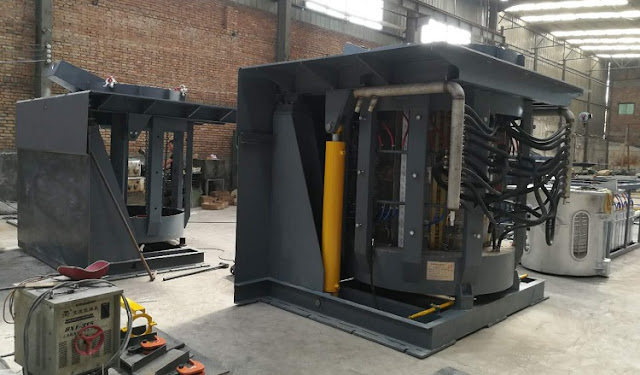The Core Principle of the Intermediate Frequency Melting Furnace
The working principle of the intermediate frequency melting furnace is that the three-phase AC power supply provided by the State Grid forms a voltage-adjustable pulsating DC current through a three-phase full-controlled rectifier bridge (the device uses a thyristor). The DC current is filtered by the reactor LD and sent to a single-phase inverter bridge (the device uses a thyristor). The output of the inverter bridge is several tens to hundreds of times higher than the power supply frequency. The load adopts LC series-parallel oscillating circuit composed of the induction coil (including heating furnace charge) and intermediate frequency power capacitor, which has strong adaptability to load and reliable operation. By adjusting the control angle of the rectification trigger pulse, the rated power can be changed to achieve the purpose of power adjustment; the output frequency is the resonant frequency of the LC parallel oscillator under load. Since the trigger pulse control signal of the inverted bridge is taken from the load loop, when the LC parameter of the load loop changes, the output frequency of the inverted bridge will also change accordingly, and the automatic frequency modulation function is performed.
The frequency of the intermediate frequency melting furnace is between 50 Hz and 10 kHz, and the frequency converter is required for frequency modulation. The medium frequency induction melting furnace has the advantages of high electric and thermal efficiency, short melting time, less power consumption, less land occupation, less investment, flexible production, and easy process automation. Suitable for the smelting of various cast irons, especially alloy cast iron, ductile iron, vermicular cast iron. It has strong adaptability to the burden, and the type and size of the burden can vary widely. Medium frequency induction melting furnaces have advantages not found in other ironmaking furnaces. In recent years, it has achieved remarkable development and has been widely used in the production of cast iron. The medium frequency induction melting furnace has high production efficiency and the melting cycle can be shortened to about 35 minutes. In order to make the furnace more powerful, the slag must be removed as soon as possible. The slag remover or manual slag removal effect is poor, the time is long, and the working conditions are poor. To this end, a method of pouring slag from the furnace is proposed, which is to pour 20-25 degrees behind the furnace and pour the slag into the truck through the trough at the top of the furnace body. This method is quick and easy. The medium frequency induction melting furnace must be repaired after the movement.
The core of the intermediate frequency melting furnace is that the effect of the cold extrusion copper tube and the cast copper tube of the induction coil is far from the price. Cold extruded copper tube with T 2 large section. The surface insulation of the copper tube is treated by electrostatic spraying to achieve Class H insulation. In order to protect the insulation strength of the mica tape, the mica tape and the alkali-free glass ribbon should be wound on the surface once and then coated with a moisture-proof insulating enamel. There is a certain gap between the turns of the coil. When the refractory mortar is applied to the coil, the refractory mortar should penetrate into the gap to enhance the adhesion of the mortar on the coil. After the refractory mortar is built, the inner surface of the coil is smooth, which is convenient for removing the lining and protecting the coil. Add a few turns of stainless steel water-cooled coils at the upper and lower ends of the coil to increase the overall rigidity and facilitate heat dissipation. In terms of the choice of an aluminum shell furnace shell, the standard 1-ton aluminum shell furnace weighs 400 kg of cast aluminum alloy and has a thickness of 40 mm. In some factories, the furnace shell is often thickened and not thick enough. The steel shell furnace is very important for the choice of the yoke. The choice of the same type of steel shell furnace yoke is different, the price difference is very large. In general, high permeability Z11 cold-rolled silicon steel sheets should be used. The silicon steel sheet has a thickness of 0.3 mm. Use a contoured structure. The inner arc surface of the induction coil is the same as the outer arc so that the yoke is close to the outer side of the induction coil, and the restraining coil radiates magnetic lines outward. The yokes are clamped on both sides by stainless steel plates and stainless steel, welded and fixed, and cooled with water.
Free Send inquiry to stella@hanrm.com
Whatsapp/Wechat:+8615877652925
Website: https://www.hanrm.com



评论
发表评论